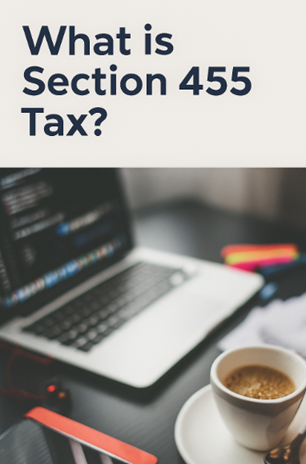-
News
-
Blog
-
Archive

Understanding Section 455 for Company Directors
If you are a company director, or closely connected to one, it is important to understand how Section 455 works. Many directors borrow money from their limited company through a director's loan account, but if the balance is not managed properly, HMRC can impose a significant tax charge. This rule exists to prevent directors withdrawing funds without paying the correct tax, and it mainly affects close companies controlled by a small number of shareholders. Although not every business encounters it, failing to manage a director's loan correctly can be costly.
What Section 455 Tax Actually Is
Section 455 tax applies when a director or participator borrows money from their company and does not repay it within a specified timeframe. A participator includes shareholders and those who benefit from the company's finances. The tax is temporary, but the company must pay it upfront if the loan remains outstanding nine months and one day after the end of the accounting period in which it was taken. HMRC introduced this rule to stop directors treating company funds as personal loans instead of taking earnings through salary or dividends.
The Timing Rules You Must Know
This tax charge can be reclaimed later if the loan is repaid or written off, but the reclaim process can take time. Directors should therefore plan ahead to avoid cash-flow strain. Understanding when the charge applies and how timing affects your tax position is essential to avoid accidental non-compliance.
Current Section 455 Tax Rate
The current Section 455 rate is 33.75% for loans made on or after 6 April 2022. Before this date, the rate was 32.5%. The charge mirrors the higher dividend tax rate, reinforcing HMRC's intention that company profits should be taken transparently. For example, if a director withdraws £10,000 and does not repay it by the deadline, the company must pay £3,375 to HMRC. Once repaid, the company can apply to reclaim the charge.
How Section 455 Is Paid
Section 455 tax is paid as part of the company's Corporation Tax return. The loan must be disclosed on the CT600A supplementary pages. Although paid alongside corporation tax, it is not based on profit only on the value of the outstanding loan. Ensuring your accountant reviews your loan balances before filing is essential to avoid penalties or incorrect submissions.
Payment Deadlines and Filing Rules
For most companies, the Section 455 charge is due nine months and one day after year-end, matching the standard corporation tax deadline. Larger companies may pay in quarterly instalments, but most small companies will pay on the usual timeline. Once paid, the reclaim period begins, provided the loan is eventually settled.
Reclaiming Section 455 Tax
Reclaim timing depends on when the loan is cleared. If repaid within the current or previous two accounting periods, the company can reclaim the charge through the corporation tax return. If older, HMRC requires form L2P. HMRC can take time to process repayments, so good record-keeping and timing awareness are important.
When Section 455 Does Not Apply
If the loan is repaid within nine months and one day, no charge applies. Small employee loans of £15,000 or less may also be exempt if the employee has no major company interest. Genuine commercial loans and trade credit balances can also fall outside Section 455 when documented properly.
HMRC Anti-Avoidance Rules
HMRC prevents directors from repaying loans just before the deadline and taking them out again shortly after. Under the 30-day rule, if a repayment and similar withdrawal occur within 30 days, HMRC treats the original loan as unpaid. A further rule applies where loans exceed £15,000 and there is intent to reborrow. These rules ensure genuine loan repayment.
What Happens When Loans Are Written Off
If a director's loan is written off, it becomes taxable income for the director, often treated as a dividend. If the director is also an employee, National Insurance may apply. In insolvency, liquidators often require repayment of director loans, and unpaid balances can still trigger Section 455 liabilities.
Managing Your Director's Loan Account
Director's Loan Accounts require proper bookkeeping. Regular withdrawals can unintentionally create overdrawn balances, triggering Section 455. Dividends used to clear balances must be properly declared and supported by profits. Dividends declared after the deadline do not stop Section 455 from applying, so planning is critical.
Why Good Planning Matters
Understanding Section 455 and keeping your director's loan account in order is part of responsible business management and wider corporate tax planning. With proper structure, documentation, and advice, directors can avoid cash-flow issues and HMRC penalties.
Professional Help from YRF Accountants
YRF Accountants helps limited company directors manage director loans correctly, avoid Section 455 pitfalls, and reclaim tax where payable. If you want expert advice, support with CT600A submissions, or guidance reclaiming S455 tax, our experienced team is here to help. For clear advice from trusted accountants Bolton, contact YRF Accountants today and keep your finances compliant, efficient, and well-structured.